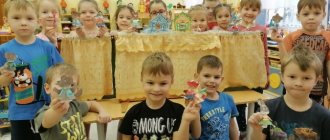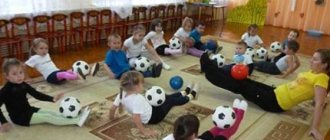Child-parent project on the topic: “I will save my health - I will help myself!!!”
The Ogorodnikov family - mother Anna Vladimirovna and son Yaroslav (pupil of the preparatory group of MBDOU d/s No. 38)
2014
Project theme : “I will save my health - I will help myself!!!”
Project type : informational, long-term, developmental.
Project areas : health and physical education.
Relevance: Currently, there is a constant search for methods of improving the health of children. The main goal is to reduce morbidity. First of all, the child’s ability to master all the skills and abilities that are instilled in him at home, in kindergarten and that he needs for effective learning in the future depends on his state of health. To do this, it is necessary to develop in the child versatile knowledge and positive character traits, and improve physical development. Physical activity is an essential component of a preschooler’s lifestyle and behavior. It depends on the organization of his physical development, on the level of preparedness, on living conditions, individual characteristics and functional capabilities of the growing organism. Insufficiency of motor functions in children is manifested in all components of motor skills: in general, in fine movements of the hands and fingers, in facial and speech motor skills, which leads to poor coordination of movements in complex self-care activities, in labor processes; causes difficulties in mastering manual operations (writing, drawing, affects the expression of facial expressions and pantomimes, the formation of the expressive side of speech, correct and clear sound pronunciation).
Objective of the project:
- Increasing the child’s theoretical knowledge and practical skills in developing their own health;
- Formation of integrated connections between motor, intellectual, and communication abilities;
- Creating a health-preserving environment, reducing the incidence of diseases in winter and spring;
Achieving your goals is possible if you solve the following tasks:
- Introduce the child to the main factors influencing health;
- Create conditions for maintaining and strengthening health;
- To develop a child’s understanding of the need to take care of their health, take care of it, learn to be healthy and lead a healthy lifestyle;
- Instill a love of physical exercise and hardening;
Project principles
- the principle of diversified personality development
activation of mental activity, creation of conditions in which the child himself seeks a rational solution.
- the principle of humanization
Physical education and health activities are based on comfort, taking into account the desires and moods of the child.
- the principle of individuality
ensuring a healthy lifestyle for the child, taking into account his health, interest, selection of optimal physical activity.
- the principle of cyclicality and systematicity
gradual increase in load as physical fitness increases.
- health principle
ensuring a rational general motor regime, alternating motor and cognitive activity.
The project is being implemented in two directions:
- Joint activity: child and parents.
- Individual research activity of the child.
Forms of working with children:
— flexible daily routine and optimal organization of routine moments;
— morning gymnastics, gymnastics (story-based, with objects, from outdoor games, rhythmic, in the fresh air), self-massage, eye exercises;
— physical education classes at home and in the open air (games, story-based, thematic, complex, control and diagnostic, training with benefits and gifts);
— recreational running, barefoot walking;
- invigorating gymnastics (including corrective exercises for the prevention of flat feet, poor posture; breathing, articulation, visual, finger exercises, development of speech breathing, gymnastics for the development of auditory attention, exercises for tension and relaxation, play massage);
- hardening activities (barefoot walking, lightweight clothing, walking on massage mats, extensive hand washing, sunbathing);
— garlic and onion inhalation;
- massage;
- balanced diet;
— conversations: “I love vitamins - I want to be healthy”;
— examination of illustrations, photographs about sports;
- learning proverbs and sayings about health;
- reading fiction: K. Chukovsky “Moidodyr”, A. Barto “Greasy Girl”, S. Mikhalkov “Vaccination”, “About a girl who ate poorly”, “About mimosa”, “Pripp”, “I’m 36 again” ,5”, G. Oster “Petka-microbe”, etc.;
Expected results:
- the child’s awareness of the need to lead a healthy lifestyle;
- mastering self-healing skills;
- increasing responsibility for your health.
reducing morbidity, increasing physical activity and physical fitness;
- formation of basic ideas about the benefits of physical education, mastering cultural and hygienic skills.
| Stages of work on the project | ||
| Project stages | Parents' activities | Child activity |
| Stage 1 Preparatory | 1. Determining the level of knowledge of parents and their readiness to work on the project 2. Creation of a creative group (mom, dad, son). 3. Define criteria, stages and duration 4. Selection of materials and literature on this topic 5. Drawing up a work plan | Getting into the problem |
| Stage 2 Practical | 1. Forms and methods of work of parents:
2. Forms and methods of working with a child:
| The child’s participation in preparation, the formation of prerequisites for his independent search activities, the formation of a sustainable interest in physical education. |
| Stage 3 Final | 1. Tracking work results. 2. Organizing a photo gallery. | 1. Acquisition of new knowledge, skills and abilities. 2. Problem resolution. 3. Receiving a health cup and a longevity medal. |
In order to maintain health, to strengthen your body, my whole family knows there must be a daily routine.
Guys, you should know. Everyone needs to sleep longer. Well, don’t be lazy in the morning - get ready to exercise!
Brush your teeth, wash your face, and smile more often, toughen up, and then you won’t be afraid of the blues.
Health has enemies, don’t make friends with them! Among them is quiet laziness, you fight it every day.
So that not a single microbe accidentally gets into your mouth, wash your hands before eating with soap and water.
Eat vegetables and fruits, fish, dairy products - This is healthy food, full of vitamins!
Go for a walk and breathe in the fresh air. Just remember when leaving: Dress for the weather!
Well, if it already happened: You got sick, Know that it’s time for you to see a doctor. He will always help us!
These are the good tips, The secrets are hidden in them, How to maintain health. Learn to appreciate it!
Don't start a new life on Monday,
and from morning exercises.
"Let's lead a healthy lifestyle!!"
Anyone who plays sports gains strength!
Anyone who loves sports is healthy and cheerful.
Both ingenuity is needed, and hardening is important!
“Temper your body for good. Don’t be afraid of the cold, wash yourself up to your waist!”
"Olympic hopes!!!"
If you are not friends with sports, you will worry about it more than once!!!
FOODS FOR CONSIDERATION
Getting ready for recovery
It is no secret that in winter children get sick very often, which negatively affects the immune system, so we have to strengthen the child’s immunity. In the spring, it is advisable to begin strengthening it with the help of vitamin complexes, herbal preparations and fish oil capsules. The prescription of each of these drugs requires prior pediatric consultation, since there is a risk of exaggerating the dose, which can have a detrimental effect on children's health. As a rule, vitamins are prescribed to children after the first year of life, those who are often ill, after prolonged intoxication, antibiotic therapy, etc. Herbal infusions are also very effective in stimulating the immune system; immunomodulatory complexes based on medicinal plants such as echinacea are especially strong. Only long-term systematic use for two to three weeks guarantees a positive result.
Healing dream
Sleep has a beneficial effect on the body, giving rest, and with it, recovery at home. Scientists have proven that the physiological strengthening of the immune system during sleep occurs an order of magnitude faster than during wakefulness. Therefore, it is very important to follow the sleep schedule recommended for a child at a certain age. Babies up to four months of age sleep on average seven to eight hours during the day and seven to eight at night. Then until the age of eight months - a maximum of five during the day and approximately nine to ten at night. As the year progresses, the number of hours of daytime sleep decreases to four, and nighttime sleep increases to twelve. After two years, the child switches to one- or two-hour daytime and eleven-hour night sleep.
Products for improving the health of the child’s body
The spring menu must satisfy the baby’s increased needs for vitamins and nutrients, which will give the child an energy boost and improve health. Vegetable and fruit dishes must certainly be included in the diet, even in the form of canned food for children. In spring, the first fresh vegetables appear, which must be purchased only in specially equipped stores that have all the necessary certificates of conformity and quality. In addition, you can grow your own greens, which will give you a guarantee that this is an environmentally friendly product that will not only not harm your baby, but will also provide it with the necessary vitamins and microelements at home.
The ideal spring diet for a child includes:
Meat products
- 50 g per day or every other day, and the meat should be varied: beef, pork, poultry (chicken, turkey).
Fish dishes
- Fish dishes are included in the menu at least once a week. In your baby’s diet, it is better to use mainly sea fish, rich in very healthy omega acids.
Egg white and yolk
- These products are acceptable in a child’s diet up to four times a week.
In order to satisfy the child’s growing energy costs and, therefore, contribute to the health of the body, nutrition must be according to a regimen and balanced in portions (a child’s portion should not be equal to an adult’s portion).
Project result:
The project achieved its objectives. The child gained new and expanded existing knowledge, became interested in preserving his health, and improving physical fitness. The incidence of diseases in this winter-spring period has decreased compared to the previous season.
Conclusions:
- The child has developed practical knowledge and skills to develop a healthy lifestyle.
- The child demonstrates the ability to use outdoor games in independent activities.
- The incidence rate has decreased.
- Deep personal involvement in project activities gave impetus to creative self-development and increased the child’s interest in self-development.
- My literacy in matters of raising and promoting the health of a preschooler has increased.
- The joint emotional experience of our family members has been enriched.
- The activities of this project will continue.
Literature:
Health ABC book /L.V. Bal, V.V. Vetrova, 1995
Theory and methods of physical education and child development. Textbook /E.Ya. Stepanenkova - M, Academy, 2001/
“The ABC of physical education minutes for preschoolers” V.I. Kovalko
Formation of moral health of preschool children: activities, games, exercises / Ed. L. V. Kuznetsova, M. A. Panfilova - M: TS “Sfera”, 2002
CONDITIONS OF APPEARANCE
It is necessary to instill the habit of a healthy lifestyle from childhood. Preschool education plays a huge role in shaping children’s ideas about a healthy lifestyle. Often, the correct organization of educational work with children and parents is more effective than a system of medical and hygienic measures.
In this regard, kindergarten and family are called upon to lay the foundations of a healthy lifestyle even in preschool age, help them understand the value of health, and encourage children to independently and actively form, maintain and increase their health.
That’s why I developed the project “We Choose Health!”
The project was founded by:
— on creating a unified system of interaction between teachers and parents in the field of introducing children to a healthy lifestyle in order to create around them an atmosphere filled with the needs, traditions and habits of a healthy lifestyle;
- on the systematicity and complexity of activities of a health-improving and pedagogical nature;
— taking into account the age, psychophysical and psychological characteristics of children of senior preschool age;
— on the basic principles of psychology and preschool pedagogy.
THEORETICAL BASIS
There is a large number of studies confirming the need to use health-saving technologies. So, according to data, a person’s health depends 50% on the lifestyle he leads. The relationship between lifestyle and health is expressed in the concept of “Healthy lifestyle”. A person’s attitude towards a healthy lifestyle does not appear by itself, but is formed as a result of a certain pedagogical influence. In the works, and it is noted that the formation of valeological culture is determined primarily by the process of education, pedagogical interaction between an adult and a child, and a wide range of pedagogical means and techniques. Adults must do everything possible to ensure that the sphere of childhood is valeological, that is, healthy.
The project is based on scientific and methodological developments and recommendations set out in the “Safety” program by the authors, which addresses the problems of a safe existence, on which the health of children depends. The main general educational programs are: The main educational program of the MBDOU Syavsky kindergarten “Bell”, “Approximate general educational program of preschool education “From birth to school” edited by , , . In addition to the main comprehensive programs, when organizing the project, the methodology for creating a healthy lifestyle for children, set out in the methodological guide “Introducing preschool children to a healthy lifestyle” (, , ), was taken as a basis, and the methodological guide “Health-saving technologies in preschool educational institutions” was used.
The fundamental idea of this project is the provision that upbringing and education should be built on the activity of the child himself. The approach is based on the application of the principle of mindfulness in working with preschoolers, i.e., children’s understanding of the independence of maintaining their health and independent choice of a healthy lifestyle.
FUNDAMENTAL PRINCIPLES
1. The principle of science
–
the use of scientifically based and proven programs of technologies and methods.
2. The principle of an individual approach and continuity
-
maintaining connections between age categories, taking into account different levels of development and health status of pupils.
3. Accessibility principle
– use of health-saving technologies in accordance with the age characteristics of children.
4. Systematic principle
– implementation of health and preventive measures constantly, systematically, and not occasionally.
5. Activity principle
– participation of the entire team of teachers and parents in the search for new, effective methods and targeted activities to improve the health of themselves and their children.
6. The principle of connection between theory and practice
develops in children the ability to apply their knowledge of maintaining and promoting health in everyday life.
PROJECT DURATION
The project is medium-term. The duration of work on the project covers an academic year and includes the following stages:
The first stage is preparatory (June-August)
.
Goal: To identify the level of development of primary knowledge in children of senior preschool age about a healthy lifestyle, plan work taking into account the results of primary diagnosis, collect the necessary information, and prepare equipment.
The second stage is the main one (September-April)
.
Goal: working with children, working with parents, preschool staff, equipping a subject-development environment.
The third stage is
the final stage (May).
Purpose: To identify the level of development of knowledge about a healthy lifestyle in children of senior preschool age, the effectiveness of using the acquired knowledge in everyday practice, the level of physical development and readiness for schooling; systematization of material.
At the final stage, an exhibition of posters and children's creativity “We choose health!” is organized.
RELEVANCE
On January 1, 2014, the Federal State Standard for Preschool Education came into force, a document that all preschool educational organizations are required to implement. The new standard defines health as one of the most important results of education, and the preservation and promotion of health as a priority area of activity of an educational institution. Thus, the project was developed due to the special relevance of the problem of maintaining health.
The project is based on the principles of health-saving educational technologies, which can be considered as one of the most promising systems of the 21st century and as a set of methods and techniques for organizing the education of preschoolers aimed at preserving, maintaining and enriching the health of children; formation of necessary knowledge and skills of a healthy lifestyle; use of acquired knowledge in everyday practice.
The project reflects effective approaches to a comprehensive solution to the issues of introducing children of senior preschool age to a healthy lifestyle in MBDOU; determines the main directions, tasks, as well as an action plan and their implementation during the academic year.
Novelty
the project is:
— developing a system of direct educational activities to familiarize children of senior preschool age with the basic rules of organizing a healthy lifestyle, developing skills and habits of a healthy lifestyle,
- systematization of games, game tasks, entertainment,
— developing a system for working with parents and preschool staff.
The tasks of education, training and health improvement are interconnected and focused on each child, taking into account his state of health and level of development.
EXPECTED RESULTS
After completing the project, preschoolers will be able to:
1. Name the rules of a healthy lifestyle;
2. Know the rules for maintaining and promoting health;
3. Explain the importance of health for a person;
4. Apply the rules of a healthy lifestyle in independent daily activities;
5. Give reasons for your attitude towards your own actions and the actions of your peers;
6. Maintain a favorable emotional state, communicate constructively;
7. Overcome negative emotional states (fears, anger, anxiety).
8.



